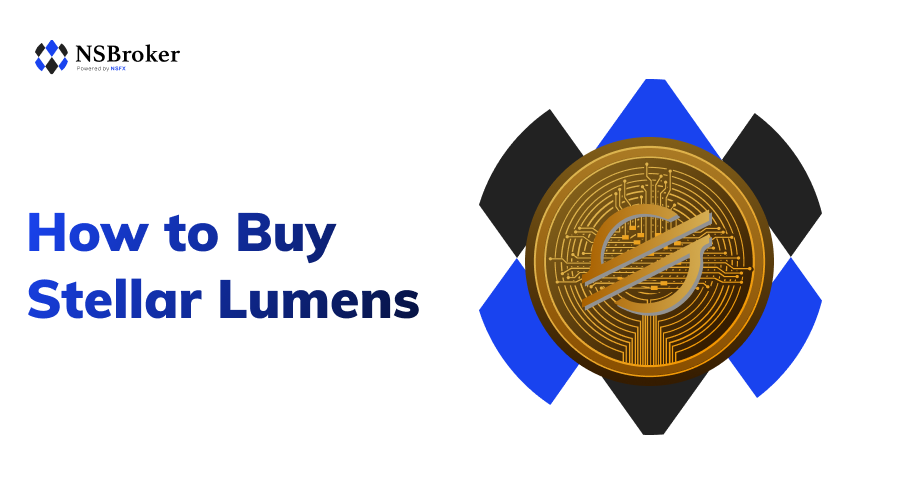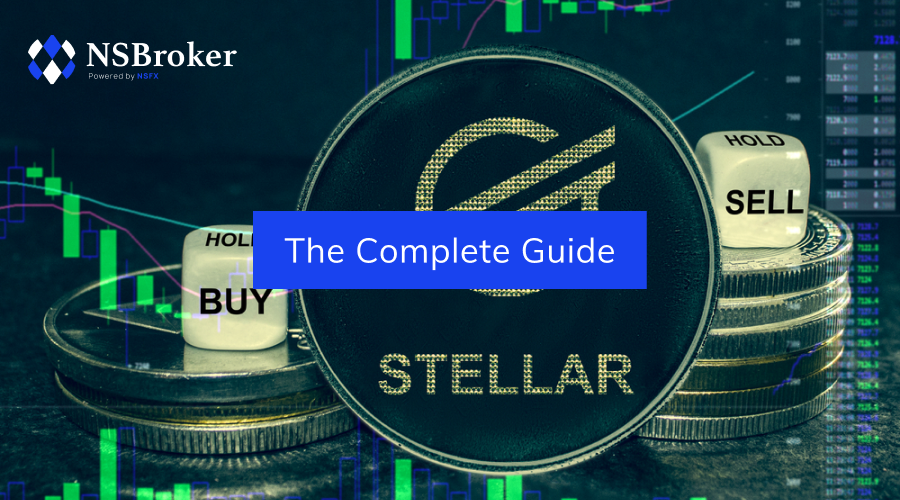How to Buy Stellar Lumens (XLM)? The Complete Guide

Stellar Lumens (XLM) advanced technology attracted investors’ attention through 2017. The altcoin has strong and innovative features to become one of the leading cryptocurrencies. Learn how and where to buy Stellar Lumens (XLM).

How to Buy Stellar Lumens (XLM)?
Unlike the larger cryptocurrencies by market cap, many exchanges do not allow the purchase of Lumens with U.S Dollars and other fiat currencies. Yet, the process can be fast and easy. Follow these steps in order to buy Stellar Lumens (XLM):
- Open an account at Changelly or Coinbase (for US citizens), and purchase Ethereum or Bitcoin (preferably ETH as it decreases the time of transfer and the cost of fees). Another option to purchase Bitcoin is a peer to peer network through LocalBitcoin.
- Now, after you bought ETH or BTC via one of the exchanges above, sign into Binance and open an account.
- Withdraw your ETH or BTC from the exchange into your Binance account. In order to do that, click the “Funds” tab and search for ETH, choose “deposit”, copy the ETH or BTC deposit address and paste it to the exchange that you withdraw the money from. The process might take up to one hour (vary according to different exchanges).
- After completing these steps, click the “Exchange” tab on the top menu and “Basic”. Search for ETH/XLM and proceed with the transaction.
- Now, after you purchased XLM, search for a digital wallet that supports Stellar Lumens and transfer the coin into the wallet. Click here for Stellar Lumens digital wallets.
In the event of a sale of Lumens, a similar process would need to be carried out, but in reverse, unless the exchange has chosen already provides for the XLM / USD pairing.
Where to Buy Stellar Lumens (XLM)?
Although Stellar Lumens is currently one of the most popular cryptocurrencies, not many exchanges allow the purchase of XLM. Here are some of the exchanges that provide the purchase of Stellar Lumens with BTC or ETH.
"Binance : One of the most recommended exchanges for altcoin trading with a variety of cryptocurrencies. Allows trading with Bitcoin, BNB, and Ethereum. Poloniex: Allows the trading of Lumens with Bitcoin and U.S. Dollars. Bittrex: Allows the trading of Lumens with Bitcoin and Ethereum. Kraken: Trading Lumens is only permitted with Bitcoin."
Stellar Lumens Digital Wallets
A cryptocurrency wallet is a virtual wallet where cryptocurrencies are stored and from where investors are able to send and receive cryptocurrencies. Investors are not able to buy, hold or sell cryptocurrencies without a digital wallet.
Using a wallet endorsed by the company behind the cryptocurrency is generally recommended and even more so if the cryptocurrency in question is not amongst the front-runners. It is also advised that any wallet chosen is secure. On this basis the existence of private keys and encryption of said keys is particularly important and holding coins on a particular exchange’s public wallet is not advised, as this could leave the coin holder exposed to cyber-theft.
Wallets and private keys should also be backed up in event that a coin holder loses the wallet or private keys in order to avoid loss of the coins being held. A loss of private keys results in the loss of the coins.
As is always the case with cryptocurrencies, having the right wallet is extremely important. For those looking to trade Lumens, a hot wallet is the most appropriate type of wallet. Hot wallets are connected to the internet and allow for easy receipt and remittance. In contrast, cold wallets are off-line and such wallets should be used when looking to hold for the longer-term. For cold wallet holders, it would still be advised to have a hot wallet that coins can be transferred to and from the cold wallet as and when the need arises.
The Stellar team has provided a range of wallets available to hold Lumens coins and they can be summarized as follows:Desktop Wallets: Ledger, Stellar Desktop Client, and Stargazer.
Mobile Wallets: Lobstr; Stargazer, Centaurus, and Papaya.
Web Wallets: Ledger, Stronghold, StellarTerm, blackwallet, LuPoEx, Lobstr, SAZA, and Papaya.
It’s been a tremendous year for the cryptomarkets, with the front-runners making headlines with their exponential gains, drawing in new investors from far and wide. As with any unregulated asset class and the introduction of new technology, there has been a mass growth in blockchain tech, with companies looking at developing blockchain tech to deliver on just about everything transferrable. The technology has certainly been embraced worldwide and is reflected in the number of cryptocurrencies that exist today and the size of the initial coin offering market through 2017.
According to ICOData, there were a total of 881 ICOs in 2017, which raised a total of $5.89bn, which is in stark contrast to a reported 29 ICOs and a total of $90.25m raised the previous year.
With more than 1,300 cryptocurrencies in existence today, investors will be looking for the next investment opportunity and there are certainly many to choose from. While some investors will likely be investing blindly, understanding a particular project or company’s blockchain technology and forming a view on whether it is likely to be successful is an important consideration in the selection process.
For Stellar Lumens (XLM), while some of the major cryptocurrencies were left floundering at the end of the year, XLM rallied 78% on the final weekend of the year, moving from a Friday opening $0.2183 to the year-ending close of $0.3885. Much of the historical gains came in the final month of the year, however, as had been the case with many of the leading cryptocurrencies, with Lumens surging 388% in December.

Stellar Lumens – A Worldwide Financial Network
Stellar, is the company behind Lumens coins and is described as a decentralized, hybrid blockchain that is fully open-source. The blockchain technology facilitates the cross-asset transfers of value, including payments.
The Company’s goal is to develop a worldwide financial network, where all users of the technology, whether people, payment networks or banks, have equal access and economic participation.
Capabilities will include:
- Remittances: Facilitates low-cost cross-border payments. Transactions on the decentralized Stellar network are resolved within a 5-second time frame.
- Micropayments: Stellar increases efficiency, while decreasing the cost of transfers of smaller sizes and offers incremental payment options to customers.
- Mobile Branches: Provides a retail banking advantage by enabling the use of mobile banking branches, which allows banks and bank equivalents to expand retail operations, with lower overhead costs.
- Mobile Money: Looks to make existing mobile money platforms more user-friendly, allowing customers to send mobile money to recipients with different providers.
- Services for the Underbanked: The Company cuts costs to allow banks and equivalents to provide financial services with low-cost accounts, loans, and microsavings.
How Stellar Lumens Works?
Each transaction is verified by miners, with the majority of miners are required to agree that the transaction did, in fact, take place before the transaction can be finalized and entered into Stellar’s ledger.
The end-to-end transaction time to reach a consensus occurs between every 2-5 seconds.
In the case of Stellar, the transfer of funds in the remittance process uses anchors. Anchors are described as entities that are trusted by remitters to hold their deposits and also issue credits into the Stellar network for deposits. Anchors are essentially bridges between different currencies and Stellar’s network.
Essentially, Anchors have two key functions:
- Accept the deposit from the remitter and issue the credit to the account address on the Stellar ledger.
- Withdrawals can then be made by returning the credit issues to the anchor.
The concept of an anchor is not a new one, with the use of electronic money-wiring companies such as PayPal similar in function to Stellar’s concept, with Stellar’s advantage being that it would bring together all of the anchors onto the same network, making the financial network truly worldwide.
The offers form an order book, which is available for each currency pairing. If a user was looking to exchange UK Bank / GBP with U.S Bank USD or UK Bank / EUR to Coinbase / BTC, the user would search through the order book to find the available rates.
In multi-currency transactions, Stellar’s platform allows users to remit any currency to an account in a different currency through an anchor that has been added to the network.
If a user was looking to send U.S Dollars to a friend in the U.S using a UK Sterling bank account, the network identifies the preferential rate for the transaction in the order book. In cases where the currency pairing has not been offered and is therefore unavailable in the order book, the network will find the best possible rate by making a ‘chain of conversions.’ The Pounds may initially be converted into EUR’s, then Lumens and then into U.S Dollars for example.
Lumens in the above case is used to facilitate a multi-currency transaction through a chained conversion. Lumens can also be used as an intermediary currency, where the Stellar platform looks for offers of GBP / XLM and simultaneously searches for offers of XLM / USD. This is an alternative to the chain conversion and also remits the remitter’s UK Pounds to the receiver in U.S Dollars.
For each transaction, there is a base fee, which is ultimately there to deter those looking to flood the network with transactions, otherwise referred to as a DoS attack. The base fee is currently set at 0.00001 XLM, with the sender required to make the payment.
In the event that a transaction has been disputed, assets issued are frozen during the dispute period. While transactions can’t be reversed on the ledger, disputes may arise when funds have been remitted to an incorrect account. The funds sent to the receiver’s account would be frozen and can be frozen in between 3-5 seconds.
Stellar Lumens (XLM) Price
Lumens may have had a stellar 2017, but things have not slowed down at the start of the year. At the time of writing, Lumens was trading at $0.5237 and that’s well ahead of December’s frontrunner, with the likes of Ripple on the back foot at the start of the year.
The coverage has been impressive as has the performance and, with the technology and interest garnered in late December, interest is unlikely to wane anytime soon.
In fact, while the cryptocurrency market got hit by the South Korean government’s threats of shutting down cryptocurrency exchanges, Lumens continued to rally. Such performance bodes well for 2018 and for investors looking to jump onto the Cryptobandwagon.
Why is the Stellar Network Better than Others?
The very fact that Stella is able to offer a platform for multi-asset class transactions, cross-border transfers sets the platform up well for the future, particularly for those looking to find the best rates on offer on a given day. While Ripple delivers a cross-border transaction platform for financial institutions, Stellar could well go one step further and take a firm grip on the retail space.
For other cryptocurrencies, fees are considered high and exchange rates are certainly far from ideal when it comes to existing platforms and that’s before considering the time taken to remit, which could be as long as a number of days. Stellar Lumens solve these technical issues.
Should Stellar be able to hold up to its end of the bargain on transaction speed, it would be hard to imagine the platform failing. Retail customers are in desperate need of a platform that delivers more favorable rates that takes away current providers’ exorbitant fees, some of which are hidden in the rates on offer.
The decentralized network brings together supply and demand in a far more efficient way and incorporates the exchange and transfer of, not only fiat currencies but cryptocurrencies that have been taking the world by storm.
Can Stellar Replace Ethereum as the ICO Coin?
Ethereum has been the ICO coin of choice and has provided seen strong support through 2017, with the boom in the ICO markets, but questions are beginning to be raised on whether Ethereum can hold on to the top spot when considering the capabilities of coins like Stellar, a hybrid that marries fiat and cryptocurrencies.
It will take some time for the markets to move forward, with a wave of ICOs launching in the early part of this year continuing to select Ethereum as the preferred choice.
For new companies and projects can ignore the sizeable interest in Stellar and Lumens’s recent rally. Those yet to define the parameters for token purchase may look towards Stellar’s offering with its flexibility an attractive one. The outlook is bright and, while Ethereum is unlikely to give up easily, it’s not always best to be at the forefront of a technological advancement. Stellar is taking advantage of Ethereum’s shortcomings and it may well come out on top.










